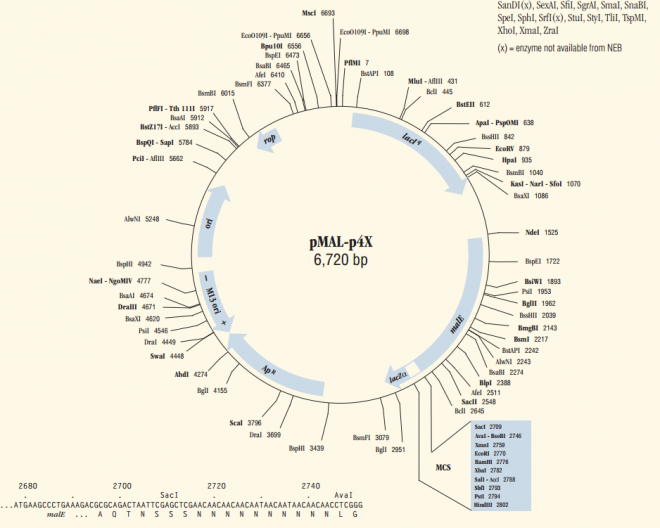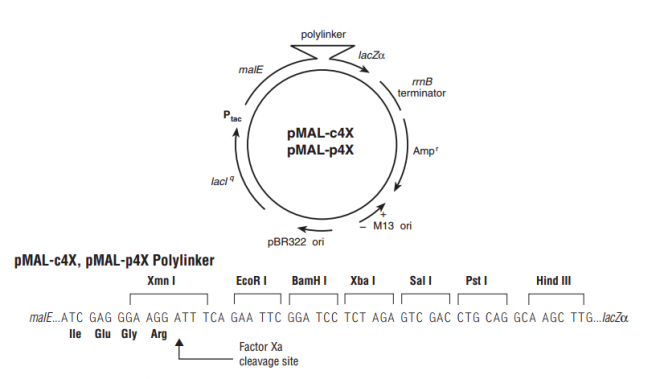pMAL-p4x 载体
| 质粒类型: | 大肠杆菌表达载体 |
|---|---|
| 表达水平: | 高 |
| 启动子: | Tac |
| 克隆方法: | 多克隆位点,限制性内切酶 |
| 载体大小: | 6720 bp (查看载体序列) |
| 5' 测序引物及序列: | MalE引物: 5'-GGTCGTCAGACTGTCGATGAAGCC-3'; MBP-F: 5'-gatgaagccctgaaagacgcgcag-3' |
| 3' 测序引物及序列: | pBad-R: 5'-gatttaatctgtatcagg-3'; M13-F: 5'-TGTAAAACGACGGCCAGT-3' |
| 载体标签: | N-MBP, N-Factor Xa |
| 载体抗性: | Ampicillin (氨苄青霉素) |
| 备注: | 融合表达麦芽糖结合蛋白MBP,蛋白定位于细胞周质。 |
The pMAL™-4 vectors (Figure 1) provide a method for expressing and purifying a protein produced from a cloned gene or open reading frame. The cloned gene is inserted downstream from the malE gene of E. coli, which encodes maltose-binding protein (MBP), resulting in the expression of an MBP fusion protein (1,2). The MBP in these vectors has been engineered for tighter binding to amylose. The method uses the strong “tac” promoter and the malE translation initiation signals to give high-level expression of the cloned sequences (3,4), and a one-step purification of the fusion protein using MBP’s affinity for maltose (5). The vectors express the malE gene (with or without its signal sequence) fused to the lacZα gene. Restriction sites between malE and lacZα are available for inserting the coding sequence of interest. Insertion inactivates the β-galactosidase α-fragment activity of the malE-lacZα fusion, which results in a blue to white color change on Xgal plates when the construction is transformed into an α-complementing host such as TB1, JM107 or NEB 5-alpha Competent E. coli (6,7). When present, the signal peptide on pre-MBP directs fusion proteins to the periplasm. For fusion proteins that can be successfully exported, this allows folding and disulfide bond formation to take place in the periplasm of E. coli, as well as allowing purification of the protein from the periplasm (8). The vectors carry the lacIq gene, which codes for the Lac repressor. This keeps expression from Ptac low in the absence of IPTG induction. The pMAL-4 vectors also contain the sequence coding for the recognition site of a specific protease, located just 5´ to the polylinker insertion sites. This allows MBP to be cleaved from the protein of interest after purification. The pMAL-c4X and pMAL-p4X vectors that are included in the system encode the site for Factor Xa (9, 10). Factor Xa cleaves after its four amino acid recognition sequence, so that few or no vector-derived residues are attached to the protein of interest, depending on the site used for cloning. pMAL vectors containing sites for alternative proteases are also available (Figure 1). The vectors pMAL-c4G (NEB #N8106) and pMAL-p4G (NEB #N8103) encode the site for Genenase™I (NEB #P8075), which cleaves following the sequence His-Tyr. The vectors pMAL-c4E (NEB #N8105) and pMAL-p4E (NEB #N8102) encode the site for Enterokinase (NEB #P8070), which cleaves following the sequence Asp-Asp-Asp-Asp-Lys.



